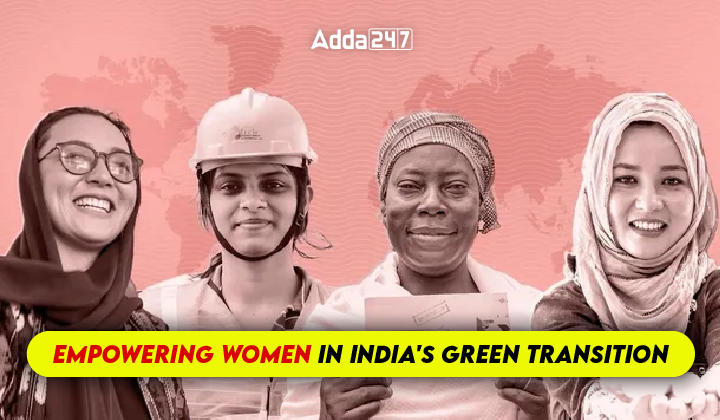Table of Contents
The Hindu published this article on the significance of green jobs and women’s Empowerment. The transition to low-carbon development has the potential to add about 35 million green jobs in India by 2047. The International Labor Organization defines green jobs as “decent jobs that contribute to preservation or restoration of the environment”. Many of these span across sectors, such as manufacturing, construction, renewable energy, energy efficiency, and automobiles, which traditionally saw a lower representation of women.
Relevance- GS Paper 1 and 3, Social empowerment, Women empowerment, Green jobs, gender gap.
Introduction to Green Jobs in India
- Potential Growth: India’s shift towards low-carbon development is poised to create approximately 35 million green jobs by 2047, signifying a significant shift in the employment landscape towards more sustainable practices.
- Sectoral Span: Green jobs encompass a wide array of sectors including manufacturing, construction, renewable energy, and energy efficiency. Historically, these sectors have seen limited female participation, hinting at a gender gap that needs addressing.
Current Gender Disparities
- Workforce Representation: Despite a remarkable 250% increase in India’s renewable energy capacity from 2015 to 2021, women constituted only 11% of the workforce in the solar rooftop sector, starkly contrasting with male-dominated sectors.
- Sectoral Employment Trends: Women’s employment is heavily skewed towards traditionally feminine sectors such as apparel, food, and textiles, while men prevail in sectors like infrastructure and manufacturing, which are pivotal to the green transition.
Challenges Faced by Women
- Societal Norms: Deep-rooted social norms and perceptions often pigeonhole women into certain roles while excluding them from technical and green job training opportunities, contributing to a skewed gender representation.
- STEM Participation: The underrepresentation of women in STEM fields critically impacts their participation in key sectors for green transition, pointing to a need for systemic educational reforms.
Benefits of Increasing Women’s Representation
- Combatting Gender Bias: Amplifying women’s presence in the green job sector can mitigate existing gender biases, promoting a more balanced and inclusive workforce.
- Empowerment and Opportunities: Elevating women’s participation not only empowers them economically and socially but also opens up a plethora of opportunities for innovation and growth in the green sector.
Strategies for Enhancing Women’s Participation
Data Collection and Analysis:
Strategic Mapping: Initiatives like the creation of comprehensive databases and conducting in-depth analyses can shed light on the current landscape of women in green jobs, guiding policy and intervention strategies.
Skill Development and Education
Targeted Programs: Programs focusing on mentorship, scholarships, and financial assistance, especially in STEM and green-related fields, can help bridge the gender gap. For instance, initiatives like the ‘Women Scientists Scheme’ (WOS-C) by the Department of Science and Technology aim to provide opportunities to women scientists and technologists.
Support for Women Entrepreneurs
Financial Inclusivity: Introducing gender-focused financial policies and collateral-free lending can significantly enhance women’s entrepreneurial ventures in the green sector. An example is the Bharatiya Mahila Bank in India, which focuses on the economic empowerment of women.
Leadership and Decision-Making
Inclusive Policies: Ensuring women’s participation in decision-making processes in green jobs can lead to more inclusive and effective environmental policies. Leaders like Sunita Narain have shown how women in leadership can influence environmental policy and action.
Policy and Partnership Development
Collaborative Efforts: Building partnerships across various sectors and stakeholders is crucial for fostering a supportive ecosystem for women in green jobs. The collaboration between the Ministry of New and Renewable Energy (MNRE) and the United Nations Industrial Development Organization (UNIDO) is an example of efforts to promote gender inclusivity in renewable energy projects.
Conclusion
Achieving a gender-just transition within the green job sector in India necessitates a concerted effort to dismantle existing structural barriers, implement inclusive policies, and actively support women’s participation. This approach not only ensures social equity but also amplifies the effectiveness and sustainability of the green transition, making it a vital component of India’s path towards sustainable development.



 TSPSC Group 1 Question Paper 2024, Downl...
TSPSC Group 1 Question Paper 2024, Downl...
 TSPSC Group 1 Answer key 2024 Out, Downl...
TSPSC Group 1 Answer key 2024 Out, Downl...
 UPSC Prelims 2024 Question Paper, Downlo...
UPSC Prelims 2024 Question Paper, Downlo...
